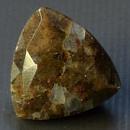|
|
||||||||||||||||
|
||||||||||||||||
|
||||||
|
|
|
|
Tephroite
|
|
| | |
| Discovered in 1823; IMA status: Valid (pre-IMA; Grandfathered) | ||
|
| ||
|
Chemistry |
|
|
| |
|
Mn2+2SiO4 | |
|
|
Manganese Silicate |
|
Molecular Weight: |
201.96 gm |
|
Composition: |
Manganese |
54.41 % |
Mn |
70.25 % |
MnO |
|
|
Silicon |
13.91 % |
Si |
29.75 % |
SiO2 |
|
|
Oxygen |
31.69 % |
O |
|
|
|
|
|
100.00 % |
|
100.00 % |
= TOTAL OXIDE |
|
|
|
||||
|
Classification |
|
|
| |
|
SILICATES (Germanates) | |
|
8/A.04-30 | |
|
|
9 : SILICATES (Germanates)
|
|
Related to: |
Olivine Group. Fayalite-Tephroite Series. Forsterite-Tephroite Series. The Mn2+ analogue of Fayalite, Forsterite, and Calcio-Olivine. |
|
Members of Group: |
Olivine Group: Calcio-olivine, Fayalite, Forsterite, Claucochroite, Kirschsteinite, Laihunite, Liebenbergite, Monticellite, Olivine, Roepperite, (of Brush), Tephroite |
|
Varieties: |
None |
|
Synonyms: |
Mangan-Peridot, ICSD 100433, PDF 35-748 |
|
|
|
|
Crystal Data |
|
|
|
|
|
Crystals typically short, prismatic, to 4 cm, or anhedral, equidimensional. Commonly in disseminated grains, compact, or massive. |
|
|
{011}, not common |
|
|
|
|
|
Physical Properties |
|
|
|
|
|
Distinct on {010}, imperfect on {001} |
|
|
Uneven to conchoidal |
|
|
Brittle |
|
|
6.0 |
|
|
3.87 - 4.12 (g/cm3) |
|
|
None. Often associated with fluorescent minerals such as Calcite and Willemite. |
|
|
Not Radioactive |
|
|
|
|
|
Optical Properties |
|
|
|
|
|
Olive-green, bluish green, gray, flesh-red, reddish brown; pale green in thin section, may be colorless. |
|
|
Transparent to translucent |
|
|
Vitreous to greasy |
|
|
1.759 - 1.860 Biaxial ( - ) |
|
|
0.101 |
|
|
r > v |
|
|
None or weak; X = brownish red; Y = reddish; Z = greenish blue |
|
|
|
|
|
Occurances |
|
|
|
|
|
Geological Setting: |
In Fe-Mn ore deposits, related skarns, and metamorphosed manganese-rich sediments. |
|
Common Associations: |
Zincite, Willemite, Franklinite, Rhodonite, Jacobsite, Diopside, Gageite, Bustamite, Manganocalcite, Glaucochroite, Calcite, Banalsite, Alleghanyite |
|
Common Impurities: |
Fe, Zn, Ca, Mg |
|
Type Locality: |
Sterling Mine, Sterling Hill, Ogdensburg, Franklin Mining District, Sussex County, New Jersey, USA |
|
Year Discovered: |
1823 |
|
View mineral photos: | |
|
|
|
|
More Information |
|
|
|
|
|
| |
|
|
|
|
Locations
for Tephroite: In the USA, from Franklin and Sterling
Hill, Ogdensburg, Sussex County, New Jersey; at Bald
Knob, near Sparta, Alleghany County, North Carolina;
and in the Sunnyside mine, San Juan County, Colorado.
From Buritirama, Piaui, Brazil. In the Harstigen mine,
near Persberg; at Långban, Värmland; and
in the Sjö mine, near Grythyttan, Örebro,
Sweden. From the Benallt mine, near Rhiw, Lleyn Peninsula,
Gwennyd, Wales. In the Meldon quarry, Okehampton, Devon,
and the Treburland mine, Altarnun, Cornwall, England.
At Val Malenco, Lombardy, Italy. From Bonneval-sur-Arc,
Haute-Maurienne, Isère, France. Large crystals
from the Wessels mine, near Kuruman, Cape Province,
South Africa. In the Kaso mine, Totigi Prefecture, and
the Noda-Tamagawa mine, Iwate Prefecture, Japan. From
Broken Hill and Tamworth, New South Wales, Australia.
On the Clark Peninsula, Wilkes Land, Antarctica. |
|
|
We
have not photographed our Tephroite
gems yet. Please
check back soon. |
